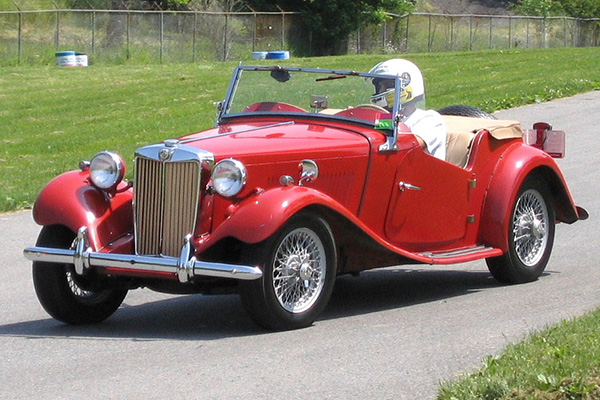
Charlie Baldwin's 1952 MG TD with Volvo B20 Engine
Owner: Charlie Baldwin
City: York, Pennsylvania
Model: 1952 MG TD
Engine: Volvo B20 four-cylinder
Built by: owner
How It Was Done
| Engine: | Volvo B20 2-liter engine, with B18 features to make it look more vintage.
Volvo B20F 'D' camshaft.
Volvo B20F cylinder head.
(This is a lower compression but big valve variant that Volvo used with fuel injection.
Fuel injector holes have been plugged.)
Dual SU HS6 carburetors.
Stock Volvo (Bosch) distributor.
|
| Cooling: | original MG radiator, with inlet and outlet ports modified and relocated. |
| Exhaust: | late Volvo B20 exhaust manifold.
Head pipe has 1.5" pipes transitioning into a 2" glass-pack,
into a Volvo 1800E muffler (2" inlet and two 1.5" outlets) with two 1.5" tailpipes. |
| Transmission: | 1965 Volvo 1800S M41 4-speed manual transmission, with
Laycock D'Normanville D-type overdrive.
Volvo stock hydraulic clutch slave fed by the clutch side of an MGA dual master cylinder,
sleeved to 3/4" bore. (Originally, both bores were 7/8" diametder.)
Shortened stock driveshaft. |
| Rear Axle: | 1972 MGB tube type, with 3.91:1 ratio. (Stock for MG TD was 5.125:1.) |
| Front Susp.: | MGA 1600 front suspension (including hubs, coil springs, and shock absorbers.)
MGB 3/4" anti-roll bar. |
| Rear Susp.: | stock MG TD leaf springs. |
| Brakes: | (master) MGA dual brake/clutch cylinder, with stock 7/8" bore on the brake side. (front) MGA 1600 disc brakes. (rear) 1972 MGB drum brakes. |
| Wheels/Tires: | 15" Dunlop painted wire wheels with 165/15 tires. |
| Instruments: | stock, except the tachometer has been converted to electronic.
The speedometer needs to be recalibrated to read correctly. |
| Electrical: | stock group-27 battery.
Lucas C40 generator, mounted in Volvo bracket.
Stock Lucas voltage regulator. |
| Body: | Halogen 7" sealed-beam headlights.
LED taillights, brake lights, and turn signals.
High-mount brake and turn signals using Lucas 1130 parking light bodies.
Lucas back up light.
|
| Completed: | Back on the road in June 2016.
Overdrive rebuilt winter 2018 |
| Comments: | This MG was my first car, purchased in the spring of 1970.
Improved safety was really the central theme of this engine swap. Power output is a safety issue because with stock engine my TD couldn't get out of its own way. Now, it cruises well on the highway. With upgraded brakes, it also stops more like a modern car. Even so, the driving experience has only improved by getting rid of the major negatives of the car. It's great fun to drive and has no issues with highway travel or covering large distances. I've installed lap belts in the car, though with wood body framing it's hard to be confident whether staying in the car in an accident would be better than getting thrown out. The Volvo B16, B18, or B20 is perfect for a T series MG because their SU carburetors are on the same side of the engine as the stock XPAG and because the Volvo engines fit with no cutting required. They look like they were put there by the MG factory. If using the Volvo 1800S remote shift setup, the gear shifter naturally falls exactly at the stock position, so a regular MG carpet kit with shift boot can be used. The Volvo hydraulic clutch is much better than the stock MG mechanical rod or cable clutch. The stock TD engine output from the 1250cc XPAG engine is 54 hp. The Volvo engines have different outputs depending on what model they came from. B16 was rated at approximately 85hp, B18 in 1800S form was rated 108hp, and B20 in 1800S form was rated 115hp. The fuel injected, high compression version of the B20 (a.k.a. "B20E") were rated 130hp. Low compression B20F's were rated 125hp. Using the B20F head with SU carbs, fuel-injection camshaft, and mild port polishing probably brings mine in around 120hp using the original factory method of stating horsepower output. Volvo B16 engines are from the mid to late 1950s, B18 engines are from the early 1960s, and B20 engines are from the late 1960s through 1975. The B16 engines have three main bearings. B18's and B20's are five main bearing engines, and are just different capacities of basically the same engine. Fuel injection became standard in 1973, but was available in 1970 in the 1800E, and 1971 in the 142E. (Some foreign car markets may have had fuel injected 122S models.) The Volvo engines are named for their capacity in CCs. Interested in a Volvo engine swap of your own? Check out: Volvo Engined MGs! New members are welcome. |
Engine Installation

Volvo B20 2-liter engine, with B18 features to make it look more vintage.

Dual SU HS6 carburetors.
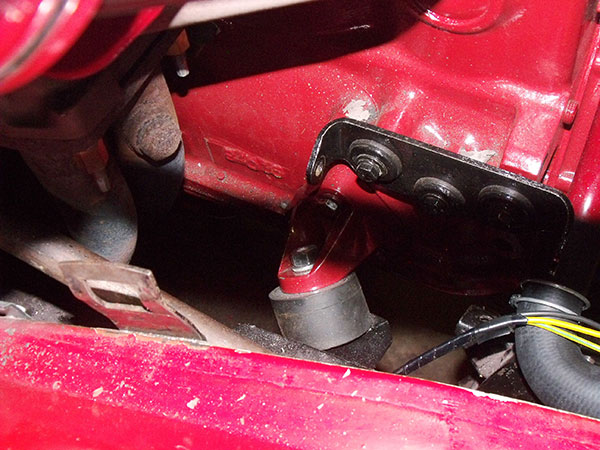
Engine mount, viewed from above.

Engine mount, viewed from below.
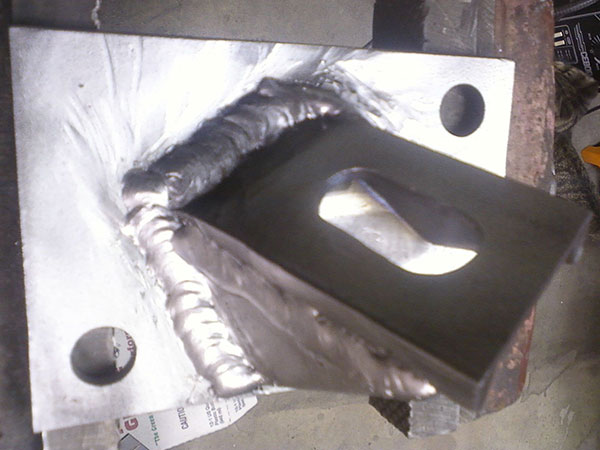
Custom fabricated engine mount, welded up.
Cooling System Modifications
The next topic that I would like to bring up is the cooling system. With the Volvo engine being
quite a bit larger in capacity than the XPAG, one may think that the T series radiator may not
have enough capacity to maintain the correct water temperature. My experience has been that
there is no problem in that respect.
You may want to modify the radiator a bit, though, to make it easier to connect it to the Volvo
engine. I have a TD, so I can only discuss what can be done with that model. The TD has a
non-pressurized cooling system as does the TC also. The TF, however, has a pressurized system.
With a TD, it does not seem to matter that the Volvo engines as used in the vintage Volvos had
pressurized systems and the TD doesn't.

Stock MG TD radiator.
The upper hose on a stock TD is 2 1/8" diameter, however, the Volvo thermostat housing where the
upper hose connects is 1" for earlier engines and 1.25" for later ones. It may be the smaller for
B18s and the larger for B20s. Either one will fit on either engine. I have a B20 with the larger
housing. I took the radiator to a radiator shop and had him remove the 2 1/8" connection and solder
in a 1.25" connection. See the pictures of the stock 2 1/8" connection and the modified 1.25"
connection. Then I made a full scale sketch from the side of the relationship between the thermostat
housing and the connection at the radiator and took it to NAPA where we went through a bunch of hoses
and picked one out that would work. This may vary depending on how you have positioned your engine.

Modestly modified MG TD radiator.
I also had the bottom connection modified by the radiator shop. A 122S or 1800E bottom radiator
hose worked here for me. Either hose is 1.25" at the radiator end. It seems like the 122S hose
will work best on my car.
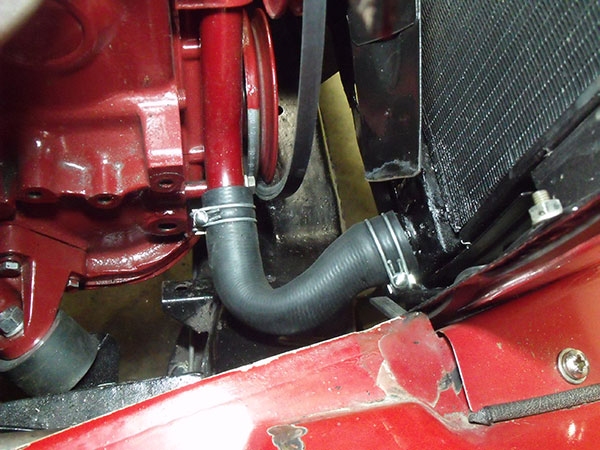
Lower radiator hose connection.
The correct bottom hose is shaped so it has more room to avoid the generator pulley from cutting it.
See all of the pictures on this. The difference between the 122S and 1800E bottom hoses is slight.
The 1800E hose is around 1/2" longer at the radiator end. I ended up taking my radiator back to the
shop to have him move the connection over to the right hand side as far as it will go. The idea is
to get it into the bottom corner. It would also probably help to have it angled down a bit on my
car since the hose needs to be angled up. Some may have to cut off some of the hose at the engine
end, but I did not.
My opinion is that it is best to modify the radiator at the bottom in this way so that the fan
blades do not have to be cut shorter. Since the Volvo engine sits lower in the car than the MG
engine the fan will hit the stock bottom connection and also the drain petcock. On mine I elected
to just plug the drain hole in the radiator and to empty it loosen the bottom hose with a tub under
the cross member to catch the coolant.
Transmission Installation

Volvo bellhousing.

Volvo M41 transmission with Laycock D-type overdrive.
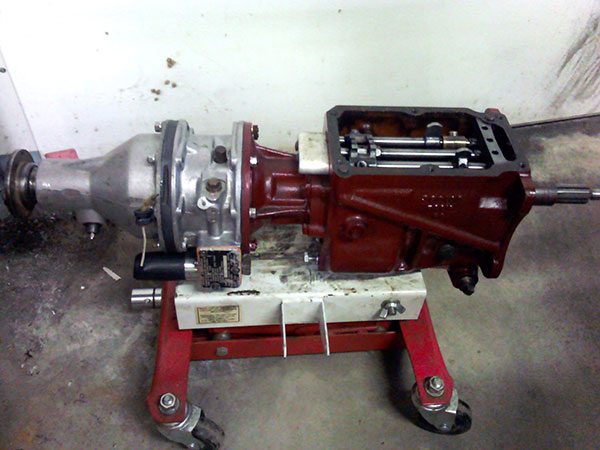
Internally a Volvo M41 gearbox is similar to a Volvo M40 gearbox. Difference? The M41's mainshaft
extends through the adapter between gearbox and overdrive unit, and through the overdrive unit.
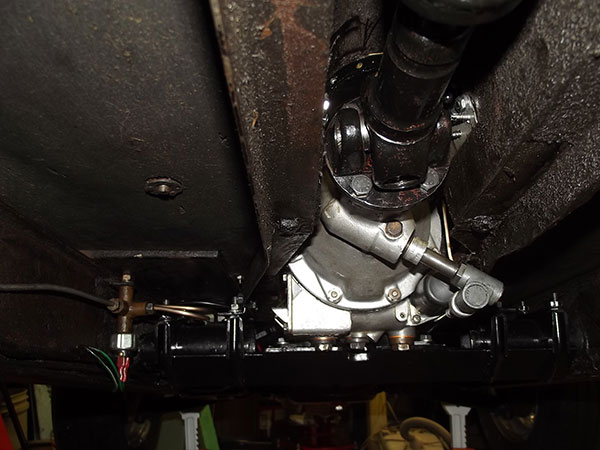
Propeller shaft installed.
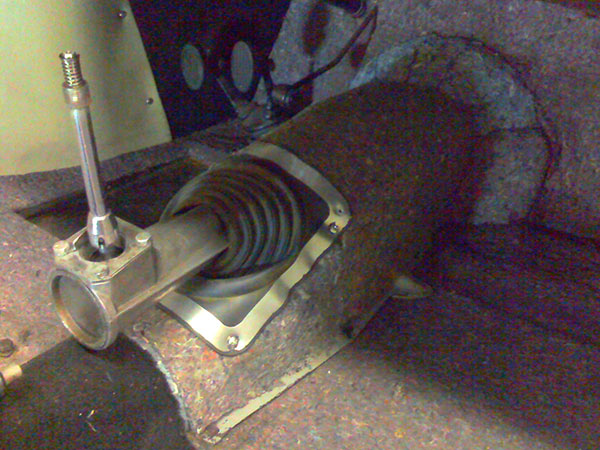
Transmission insulation and rubber excluder.
Clutch Activation
Here is one way to handle clutch activation when using the Volvo M40 or M41 transmission.
The M40 is the 4 speed and the M41 is the 4 speed plus overdrive. The earlier ones are
hydraulic and the later ones are cable operated. To me, the hydraulic activation is the
best way to go. Cable operation would require structure to pull from and a cable of the
correct length.
My opinion on the best way to activate the hydraulic clutch is to use the MGA/Bugeye
Sprite combination brake/clutch master cylinder at the pedal end. One good thing about
it is that the bolt spacing is the same as the stock TD/TF brake master cylinder and the
bore, at 7/8", is also the same.
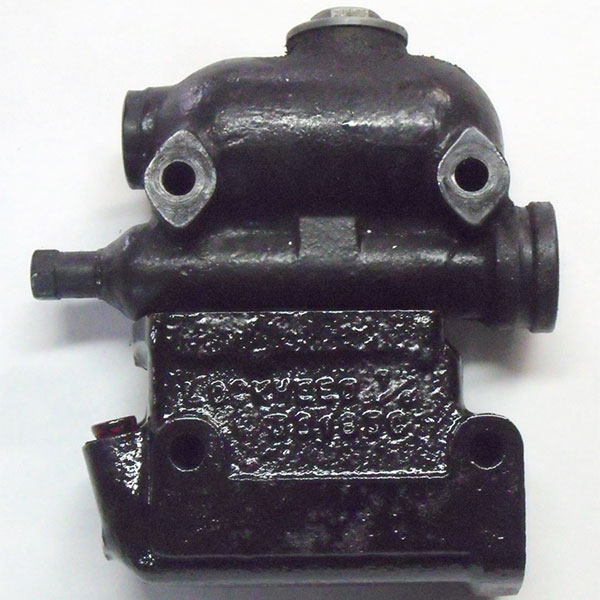
Top: MG TD/TF master cylinder. Bottom: MGA master cylinder.
Another advantage is that the brake/clutch master cylinder will mount at exactly the
same place and take up approximately the same amount of room as the original brake
master cylinder, thus requiring no extra structure to mount a separate clutch master
cylinder. The MGA braking system is very similar to the TD and TF, so there is no question
that the MGA master cylinder will handle the job.
This setup will require the MGA master cylinder to be spaced away from where it mounts
to the frame of the car in order for the push rods for the brake and clutch to line up
with the pedals.

The master cylinders, laying on the side you'd mount to the frame (on left-hand-drive car).
It can easily be seen that the center of the MGA bore is much closer to the bottom
than the center of the TD/F bore. The amount that the MGA master cylinder needs to
be spaced off the frame is 7/16" for the push rods to line up with the pedals.
On my car, I just retained the stock TD push rod for the brake side. Remember that
on the TD/F the shaft design for the pedals has the brake closest to the frame and
the clutch closest to the center of the car, which is backwards from what you would think.
So in the above picture, for a left hand drive car, the brake bore in the MGA master
cylinder is at the bottom, with the top bore being for the clutch.
The MGA master cylinder has both bores at 7/8"; however, the Volvo clutch system uses
a 3/4" bore. So the clutch side of the master cylinder needs to be 3/4", which can be
sleeved to that dimension. I sent mine away to be sleeved by Sierra Specialty in
California. They are out of business, but I understand that Apple Hydraulics can do
this work. They do brass sleeves which is what I prefer over stainless steel.
You can probably buy the master cylinder and everything from Apple.
You will also need the 3/4" piston and spring for this bore.
Because the master cylinder has been spaced away from the frame, longer bolts will be
required. On my car the thread form for the bolts is 3/8"-20 BSF. I bought a die online,
bought some longer bolts at Lowe's, cut the threaded end off, and cut the BSF threads
on them.
If you need a new master cylinder, they are being reproduced in 7/8" bore (Moss 180-670).
Part of the system is the slave cylinder mounted on the bell housing. I used the
Volvo cylinder for this since it is made to mount on the bellhousing and to push the
clutch arm. Along with that the correct push rod, return spring, return spring anchor,
and the right size bolts will be required. Then you will need to make the hard brake
and clutch lines to go from the master cylinder to the brake system union and the
clutch line forward to near to the slave cylinder. A flexible hose will be required
to connect to the slave cylinder. I used an MGA brake hose (Moss 180-831 with 324-730,
311-420, and 324-180). For the hard lines I use cunifer tubing from Fedhill Brake.
It is easier to form the flares than regular steel tubing. Fedhill can also supply
the end fittings that you will need. You will need to flare the ends of the tubing.
The MGA master cylinder should have bubble flares, not double flares. The line from
the master cylinder on the brake side will go to the same union that it went to before.
It will need an MGA fitting (3/8"-24) on the master cylinder end and a TD fitting
(3/8"-20 BSF)on the other end. The clutch side will need the MGA fitting with bubble
flare on the master cylinder end and should run forward against the frame behind the
pedal box to where you connect it to the hose that attaches to the slave cylinder.

Since the hose is an MGA one, use an MGA fitting and a bubble flare at that end also.
Next, a push rod will need to be fabricated for the clutch side. Mine needed to
be around 5 1/2" long. You will need a fork or clevis like Moss 180-315, a clevis pin
– 325-150 or 180-325, and a return spring – 180-335. A hole for the clevis pin needs
to be drilled at the same height as the one for the brake side. The existing hole where
the clutch rod connects can be used for the return spring. You will need to make a way
to attach it to the front side of the pedal box.
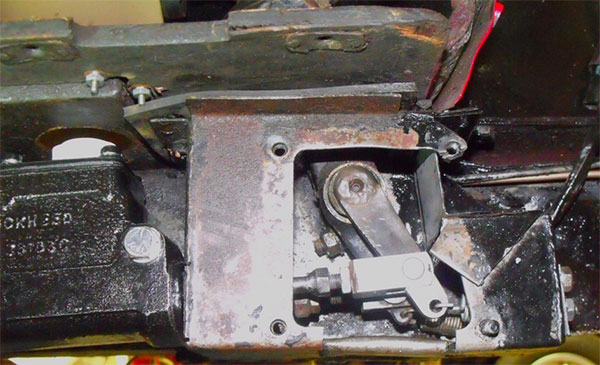
Here is what it looks like at the pedal box...
Note how the cap at the top of the master cylinder can be accessed through the
same hole in the floorboard as the original TD master cylinder.
Front Suspension

MGA 1600 front suspension (including hubs, coil springs, and shock absorbers.)
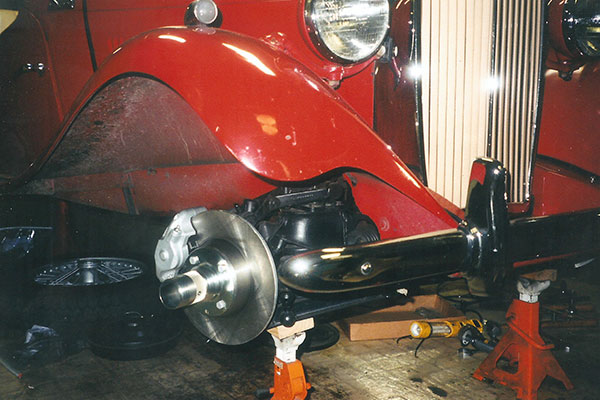
MGA 1600 disc brakes.
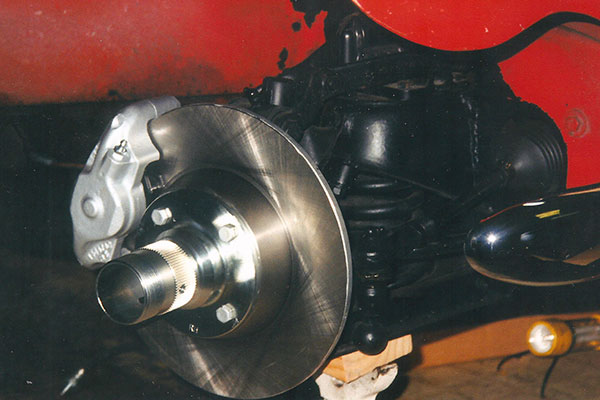
MGA brake rotor.
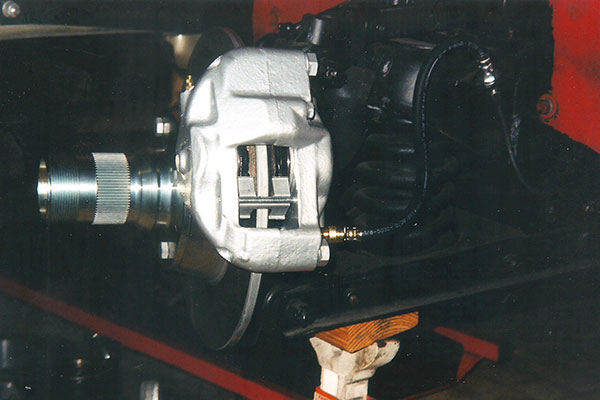
MGA brake caliper.
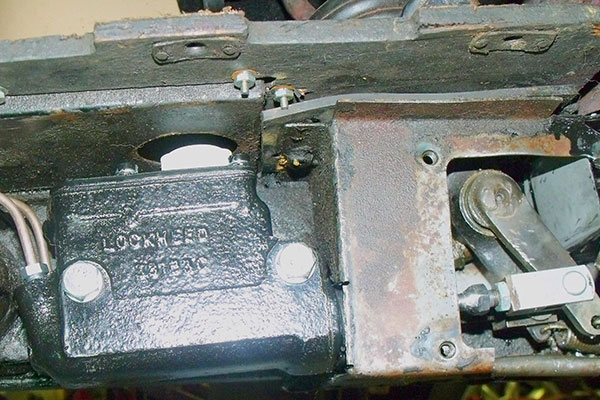
MGA dual brake/clutch cylinder, with 7/8" bore.
|
Enjoying this article? Our magazine is funded through the generous support of readers like you! To contribute to our operating budget, please click here and follow the instructions. (Suggested contribution is twenty bucks per year. Feel free to give more!) |
Exterior

Charlie autocrossing his MG TD in Carlisle, Pennsylvania. These action photos were taken before
the engine swap, but after installation of MGA front disc brakes and a 5/8" anti-roll bar.
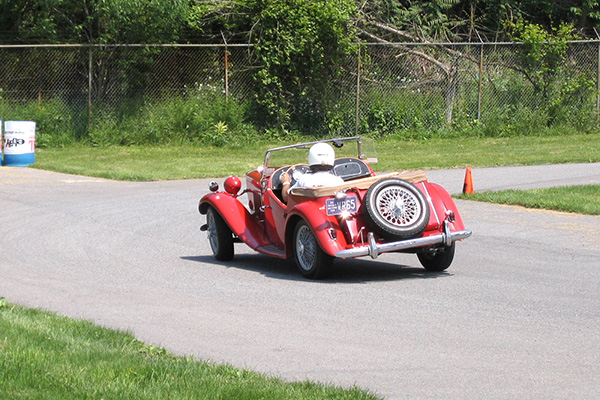
MG TD's came without any anti-roll bar, so you can imagine how much a stock TD would lean.
After this photo was taken, Charlie fitted an MGB pattern 3/4" anti-roll bar.

At an informal car show in Dover, Pennsylvania.

At Lancaster County MG Club's 17th annual "British Invade Gettysburg" car show.
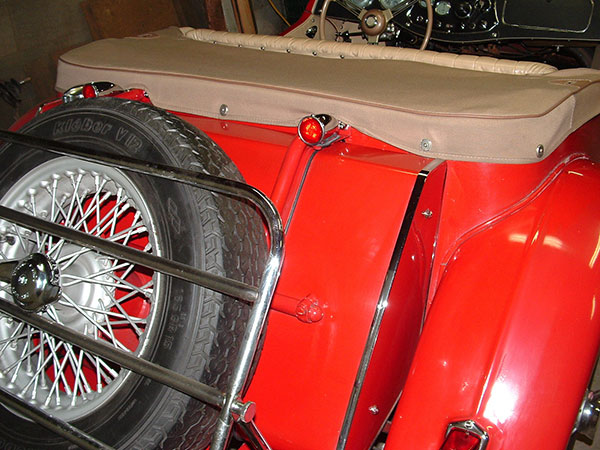
High-mounted LED brake lights.
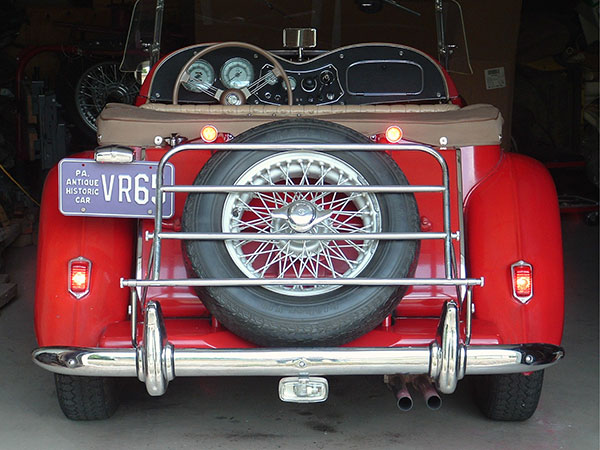
Complete rear lighting package.

At the Carlisle Import & Performance Nationals Show, 2017.
Copyright 2019. All rights reserved.
Use by written permission only.
(Do not print, copy to your hard drive, or post these online without permission.)

